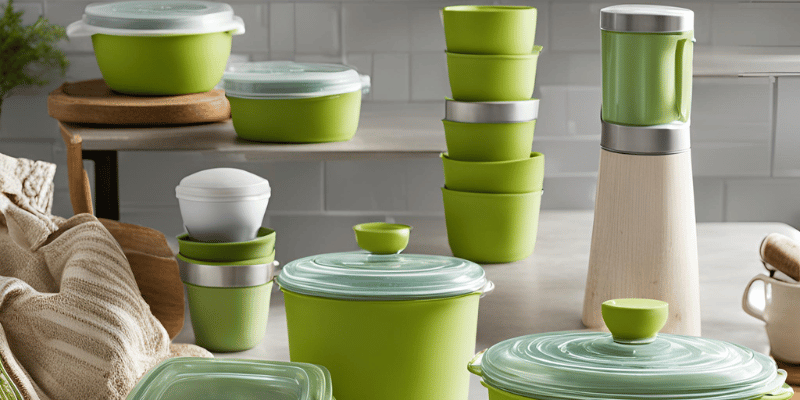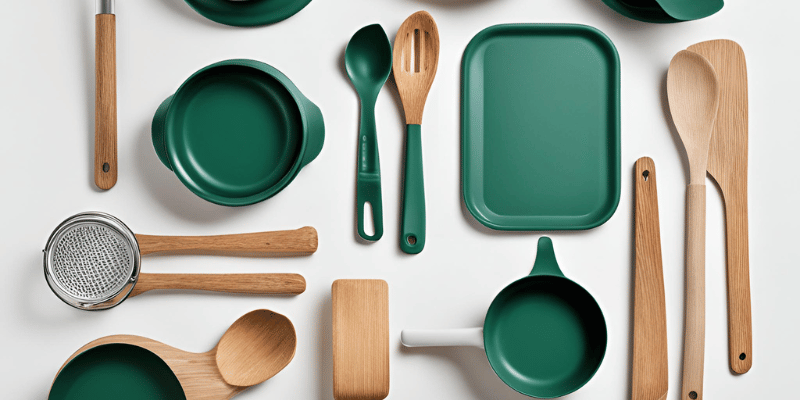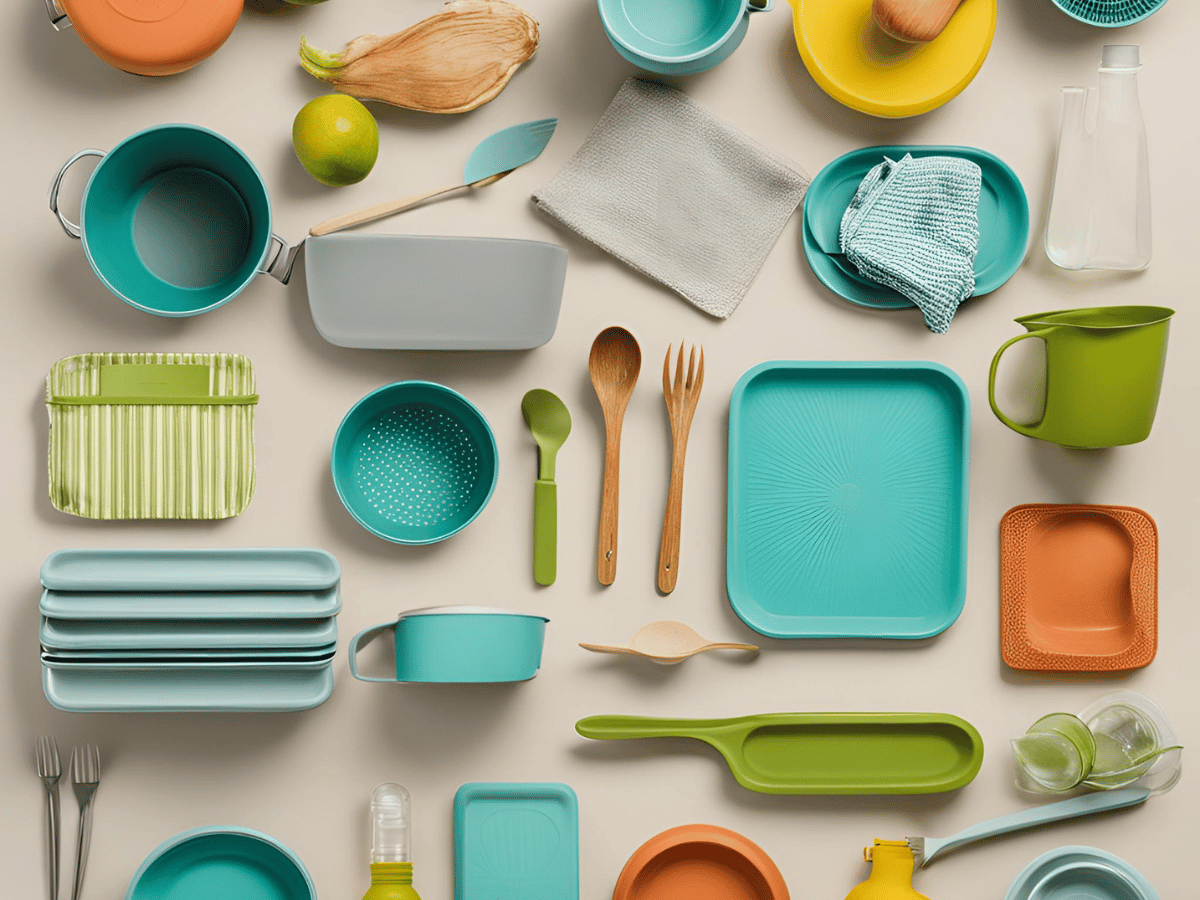Have you ever thought about the germs on your kitchen tools? Cleaning reusable kitchen products is crucial for health and the planet. It’s about more than just keeping things clean; it’s about making a difference.
By focusing on eco-friendly kitchenware cleaning, we can cut down on waste and make our kitchens better. This guide will show you easy steps and good habits to follow. These changes will improve your cleaning routine and help the environment.
Understanding the Importance of Cleaning Reusable Kitchen Products

Cleaning reusable kitchen products is key for health and the planet. Dirty items can carry bacteria and food bits, which can be harmful. For example, if you don’t clean dish brushes and cloths often, they can spread germs on surfaces where food is made.
Keeping reusable kitchen items clean helps the environment too. It makes them last longer, so you use fewer disposable items. This is good for the planet because it reduces waste and supports sustainable living.
Looking after your kitchen tools also saves money. When you clean them well, you won’t have to replace them as often. This means you get to use your kitchen items for a longer time, making them a smart choice for your wallet.
| Aspect | Description |
|---|---|
| Health | Prevents the spread of bacteria and foodborne illnesses. |
| Environmental Impact | Reduces waste by extending the life of reusable products. |
| Economic Advantage | Decreases costs through less frequent replacements of kitchen items. |
| Convenience | Provides reliable, readily available kitchen tools for daily use. |
Best Practices for Cleaning Kitchen Tools
Cleaning kitchen tools right is key to making them last longer and stay clean. It’s important to pick the right cleaners. Options like vinegar and baking soda are great because they’re safe and effective.
Each tool needs its own cleaning method. Wood tools should be washed gently to avoid damage. Use a soft soap and dry them well. Plastic items can go in the dishwasher but clean them right after to stop stains and smells.
It’s also key to clean your kitchen tools often. Things like sponges and dish towels should be changed every two weeks to stop germs from growing. Here’s a guide on how often to clean different kitchen tools:
| Kitchen Tool | Recommended Cleaning Frequency | Replacement Frequency |
|---|---|---|
| Sponges | After each use | Every 2 weeks |
| Dish Towels | Daily | Every 2 weeks |
| Cutting Boards | After each use | When visibly worn |
| Cooking Utensils | After each use | Every 6 months |
Following these cleaning tips makes your kitchen safer and more efficient. Paying attention and using the right methods is key to keeping your kitchen clean.
Eco-Friendly Kitchenware Cleaning Solutions
Looking for good ways to clean kitchenware doesn’t mean using harmful chemicals. Using eco-friendly cleaners can make your home healthier and more sustainable. This part will look at making your own cleaners and buying eco-friendly ones. It aims to give you a full way to keep your kitchen tools clean.
DIY Natural Cleaners
Making your own cleaners is simple and rewarding. Many things you already have at home can make strong, green cleaners. Items like baking soda, vinegar, and essential oils are great for this.
- Baking Soda Paste: Mix baking soda and water to clean cutting boards and get rid of tough stains.
- Vinegar Spray: Put equal parts of water and vinegar in a spray bottle for a natural way to clean surfaces.
- Essential Oil Cleaner: Add a few drops of your favorite essential oils to vinegar or baking soda mixes for a nice smell while cleaning.
Store-Bought Eco-Friendly Options
If you like ready-made cleaners, there are many good ones out there. These products are easy to use and focus on being kind to the planet. Blueland is a great brand that makes cleaning tablets you can dissolve in water at home. This helps cut down on plastic waste from traditional cleaners.
| Brand | Product Type | Key Benefits | Eco-Friendly Feature |
|---|---|---|---|
| Blueland | Cleaning Tablets | Convenient and effective | Reduced plastic waste |
| Seventh Generation | Multi-Surface Cleaner | Plant-based ingredients | Recyclable packaging |
| Mrs. Meyer’s Clean Day | Dish Soap | Gentle on hands | Bio-based formula |
Using DIY natural cleaners and store-bought eco-friendly cleaners together gives you a strong cleaning plan. These options meet different needs, letting you keep your kitchen clean and eco-friendly.
Cleaning Reusable Kitchen Products: A Step-by-Step Guide

Cleaning reusable kitchen products is key for safety and making them last longer. This guide will show you how to rinse, wash, and dry them properly. It covers different materials like plastic, glass, wood, cast iron, and bamboo.
Initial Rinse and Quick Cleaning
First, rinse kitchen items right after you use them. This removes food bits and stops stains or bacteria from forming. For example, rinse dishes and utensils with warm water to get rid of tough residue before cleaning them more.
Proper Washing Techniques
Wash kitchen items the right way, depending on what they’re made of:
- Plastic: Hand wash with a sponge and warm, soapy water. Only use a dishwasher if it’s safe for the item.
- Glass: Clean with a sponge or microfiber cloth. Dry with a lint-free cloth to avoid streaks.
- Wood: Clean with soapy water, then rinse and dry right away to stop warping.
- Cast Iron: Use a stiff brush and hot water to clean. Don’t use soap, as it can damage the seasoning.
- Bamboo Products: Wash with soap and water. Hand wash bamboo paper towels and let them air dry to keep them in good shape.
Drying Methods for Various Materials
Drying your kitchen items the right way is important. Here are some tips for different materials:
| Material | Recommended Drying Method |
|---|---|
| Textiles (e.g., towels, cloths) | Air dry or tumble dry on low heat |
| Glass | Air dry or dry with a lint-free cloth |
| Plastic | Air dry on a drying rack |
| Wood | Wipe dry immediately with a cloth |
| Cast Iron | Wipe dry with a paper towel and heat on the stove briefly |
By following these steps, you’ll take great care of your kitchen items. You’ll learn how to clean them properly, keeping them safe and lasting longer. Knowing the right way to wash your kitchen items makes cooking healthier and keeps your tools in top shape.
Maintaining and Cleaning Reusable Kitchen Goods
It’s important to take good care of reusable kitchen items to keep them clean and safe. Knowing when to clean them helps keep your kitchen safe. Regular cleaning stops grime from building up and keeps everything clean.
Frequency of Cleaning
Having a cleaning schedule for kitchen tools is key to staying clean. Here’s how often you should clean different items:
- Cutting Boards: Clean after each use to avoid cross-contamination.
- Knives: Wash after use, especially after cutting meats or raw produce.
- Reusable Containers: Clean weekly, especially if you use them for leftovers.
- Utensils: Wash after every meal to stay clean.
- Dish Towels: Wash often, at least every 3 days, to stop bacteria from growing.
Keeping up with a cleaning routine helps avoid foodborne illnesses and keeps your kitchen items in good shape.
Deep Cleaning Techniques
Regular cleaning is key, but deep cleaning is also important for a clean kitchen. Deep cleaning should happen every few months to get rid of tough grime and hard-to-reach spots.
Here are some deep cleaning tips:
- Soak and Scrub: Soak parts of appliances in warm, soapy water, then brush off any residue.
- Food Processor and Blender: Blend warm water and vinegar, then rinse well to get rid of smells and stains.
- Underneath Appliances: Take out the stove and fridge to vacuum or wipe down underneath for crumbs and dust.
- Seasonal Deep Cleaning: Do a deep clean at season changes for a fresh kitchen start.
Using these deep cleaning methods makes your kitchen fresher and healthier. It also helps your reusable kitchen items last longer.
Essential Tools for Efficient Kitchen Cleanliness
Keeping a kitchen clean takes more than just hard work. It’s about using the right tools. Knowing what cleaning tools you need can make a big difference. This part talks about picking the best cleaning supplies and green options for a better planet.
Choosing the Right Cleaning Supplies
When picking cleaning supplies, think about a few things to make sure they work well and last long. You should also think about how they affect the environment. Here are some key points to consider:
- Effectiveness: Pick cleaners that get rid of grease, grime, and germs well.
- Safety: Choose non-toxic products, especially for areas where food is made.
- Longevity: Find tools that can be used a lot and last a long time; skip disposable ones.
- Environmental Impact: Go for products that break down easily or can be recycled to lessen waste.
Suggestions for Sustainable Tools
Using green kitchen cleaning tools can really cut down on harm to the environment while keeping things clean. Here are some good choices:
- Bamboo Brushes: These are biodegradable and great for cleaning pots and pans.
- Metal Dustpans: They’re strong and can be recycled, unlike plastic ones.
- Reusable Cleaning Cloths: Ditch disposable paper towels for fabrics you can wash and use again.
- Natural Sponges: Choose sponges made from cellulose or loofah that can be composted.
| Tool | Type | Eco-Friendly Features |
|---|---|---|
| Bamboo Brush | Scrubber | Biodegradable handle |
| Metal Dustpan | Cleaning Tool | Recyclable materials |
| Reusable Cleaning Cloth | Wipe | Washable and long-lasting |
| Natural Sponge | Scrubber | Compostable |
By using these tips and picking the right cleaning tools, you can make cleaning easier and help the planet at the same time.
Conclusion
Keeping your kitchen clean is key for your health and the planet. By cleaning reusable kitchen items right, you help yourself and the environment. The tips on eco-friendly cleaning and drying help make your kitchen safe for cooking.
It’s crucial to keep reusable kitchen items clean and safe. Regular and deep cleaning stops harmful bacteria. By doing this, your kitchen shows you care about health and the earth.
We aim to make people follow a clean kitchen routine that’s good for the planet. This makes cooking better and sets a good example for the future. Taking care of your kitchen tools shows you value your health and the earth.
FAQ
Why is it important to clean reusable kitchen products regularly?
Cleaning reusable kitchen products often stops bacteria and food bits from building up. This keeps you and your family safe. Clean items also make your kitchen run smoother and last longer, cutting down on waste.
What are the best practices for cleaning different types of kitchen tools?
How you clean kitchen tools depends on their material. Wooden items need gentle soap and quick drying. Plastic and glass can go in the dishwasher. Always use the right cleaners like vinegar or baking soda for a green clean.
How often should I replace kitchen sponges and towels?
Change kitchen sponges every 2-4 weeks and dish towels once a week. Regular replacement stops bacteria from growing. This keeps your kitchen clean and safe.
Can you recommend any eco-friendly cleaning solutions for my kitchen?
Yes, there are many green cleaning options. Try making your own cleaners with things like baking soda and vinegar. Or, use products like Blueland’s tablets for a clean that’s kind to the planet.
What steps should I follow for a thorough cleaning of my kitchen utensils?
Start by rinsing utensils right after use. Then, wash them the right way based on their material. Always dry them in the air to stop moisture from causing mold.
How often should I deep clean my kitchen items?
Deep clean your kitchen items every few months. Focus on tough spots and get rid of all the dirt. Doing this with the seasons can keep your kitchen feeling fresh.
What sustainable cleaning tools should I consider for my kitchen?
Look into bamboo brushes, metal dustpans, and reusable cloths for eco-friendly cleaning. Choosing these tools helps reduce waste and makes cleaning your kitchen better for the planet.
Source Links
- Zero Waste & Eco Friendly Cleaning Guide – Going Zero Waste – https://www.goingzerowaste.com/blog/the-ultimate-guide-to-zero-waste-cleaning/
- What are some tips for keeping a kitchen clean while cooking from scratch, especially for those who tend to use multiple pots and pans? – https://www.quora.com/What-are-some-tips-for-keeping-a-kitchen-clean-while-cooking-from-scratch-especially-for-those-who-tend-to-use-multiple-pots-and-pans
- How To Clean Reusable Paper Towels – https://seekbamboo.com/blogs/sustainable-lifestyle/how-to-clean-reusable-paper-towels?srsltid=AfmBOorrHeB5I4ikqAbIb7cN_GyZ07jeuZgWDSLL0VBEit1DkiIAtk17
